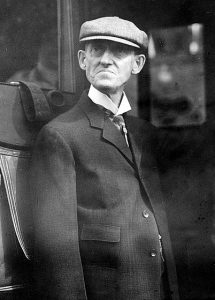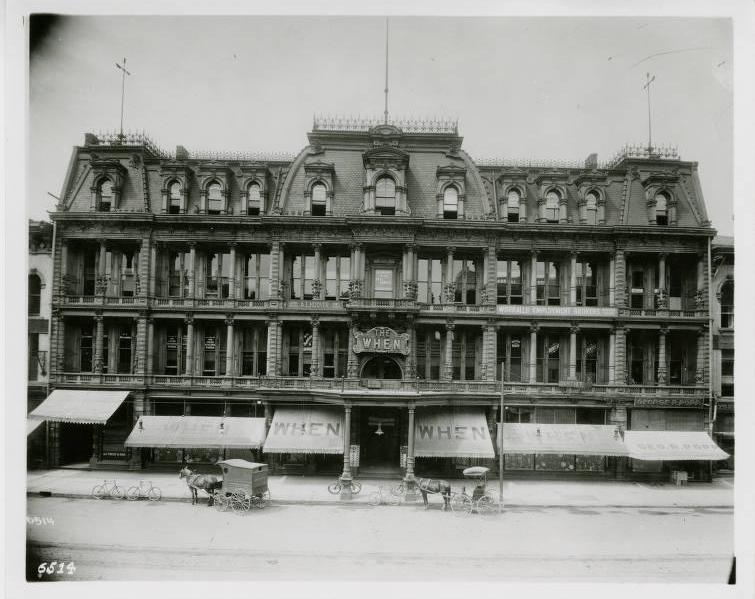
Photo info ...
(June 15, 1845-Nov. 26, 1912). Brush was a native of Clintonville, New York. When orphaned at age 4, he went to live with his grandfather. He moved to Boston at the age of 17 to pursue a career in the clothing business. During the Civil War, he served in the 1st New York Artillery. Brush suffered from locomotor ataxia, a disease of the nervous system. For most of his life, he walked with two canes.

Brush came to Indianapolis in 1875 and purchased a Second-Empire style building at 36 N. Pennsylvania St. to open the branch of a store of a New York City clothing wholesaler. He delayed the opening several times and hung a huge sign outside the building that simply said, “WHEN?” To carry his promotional scheme further, he also put advertisements in the local newspapers that carried the one-word question. By the time that the store opened for business, on March 20, 1875, the name had stuck. Brush owned the until his death.
In 1882, he backed creation of a baseball park at the present location of IU Health Methodist Hospital. To promote the When Store, Brush became involved in the ownership of a new professional team, the Indianapolis Hoosiers of the American Association. The team played in the Western League in 1884-1885, but after that one season the circuit folded.

Professional baseball did not return to Indianapolis until 1887 when Brush was instrumental in moving a National League team from St. Louis. The St. Louis Maroons also became known as the Indianapolis Hoosiers. Brush renovated his ballpark, called Seventh Street Park or Tinker Park, adding a celebrity box. Such figures as President Benjamin Harrison, Hoosier Poet James Whitcomb Riley, and novelist Booth Tarkington took advantage of these accommodations. Brush offered a tryout to Bud Fowler, the first-known African American player in organized professional baseball in 1888, but in the end, did not make the leap to bring him onto the team. After the Indianapolis Hoosiers lost league membership in 1890, Brush purchased the Cincinnati Reds National League club in 1892 and in 1903 the National League New York Giants. He owned and directed the Giants until his death.
Although Brush was prominent in the sport as owner of the Reds and Giants, he maintained his residence in Indianapolis and remained involved in local baseball. In 1894, Brush became the majority owner of a new Western League team in Indianapolis and helped the team win the pennant in 1895 by supplying players from Cincinnati. His ownership of the team continued until fellow National League owners forced him to sell his interest in the minor league club in 1896.
Under Brush’s ownership, the New York Giants won the 1905, 1911, and 1912 World Series. He suffered serious injuries when he was thrown from an automobile not long after the 1912 championship. He died while traveling by train to Southern California, where he planned to recuperate at a sanatorium. His second wife Elsie Lombard, a stage actress who was 25 years his junior, survived him. His son-in-law Harry Hemstead succeeded him as president of the Giants. The Giants named a stairway leading to the Polo Grounds stadium in Upper Manhattan in his honor in 1913.
FURTHER READING
- John Saccoman, “John T. Brush,” Society for American Baseball Research, https://sabr.org/bioproj/person/john-t-brush/.
CITE THIS ENTRY
APA:
Harton, T. A. (2021). John Tomlinson Brush. Encyclopedia of Indianapolis. Retrieved Jan 7, 2026, from https://indyencyclopedia.org/john-tomlinson-brush/.
MLA:
Harton, Thomas A. “John Tomlinson Brush.” Encyclopedia of Indianapolis, 2021, https://indyencyclopedia.org/john-tomlinson-brush/. Accessed 7 Jan 2026.
Chicago:
Harton, Thomas A. “John Tomlinson Brush.” Encyclopedia of Indianapolis, 2021. Accessed Jan 7, 2026. https://indyencyclopedia.org/john-tomlinson-brush/.

Help improve this entry
Contribute information, offer corrections, suggest images.
You can also recommend new entries related to this topic.